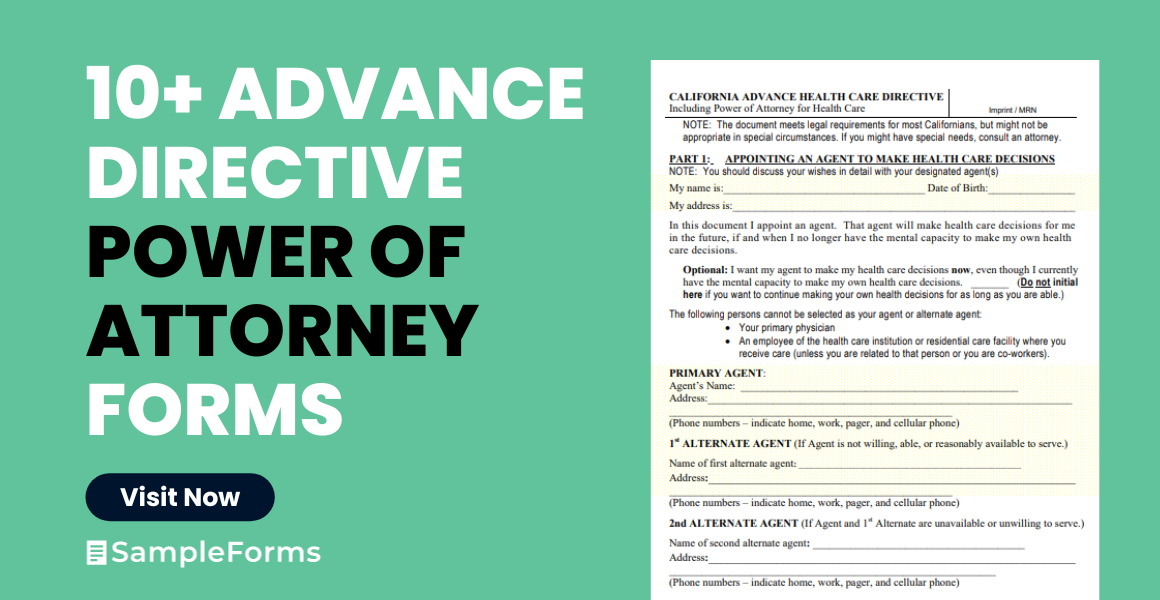Embark on a journey of proactive planning with our insightful guide on Advance Directive Power of Attorney Forms. These essential legal tools empower you to outline your future healthcare preferences and designate decision-making authority. Our guide simplifies the usage process, enriched with SEO-friendly content and practical tips. We provide clarity on how to effectively create and utilize these forms, ensuring your wishes are honored. Whether you’re planning for yourself or a loved one, our comprehensive guide offers valuable insights for navigating these crucial decisions with confidence.
What is Advance Directive Power of Attorney Forms?
Advance Directive Power of Attorney Forms are legal documents that allow individuals to specify their healthcare preferences and appoint someone to make medical decisions on their behalf if they become unable to do so. These forms typically outline instructions for treatment and care in various medical scenarios and designate a trusted person, known as an agent or healthcare proxy, to ensure these wishes are followed. This ensures that an individual’s healthcare choices are respected even when they cannot communicate them personally.
What is the best Example of Effective Communication?
Advance Directive Power of Attorney
Principal Information:
Name: ___________________________
Address: ___________________________
Date of Birth: ___________________________
Healthcare Agent Information:
Name: ___________________________
Address: ___________________________
Relationship: ___________________________
Phone: ___________________________
Healthcare Directives:
I, [Principal’s Name], appoint [Agent’s Name] as my healthcare agent to make medical decisions for me in the event I am unable to communicate my wishes. This includes decisions about:
- Medical treatments and procedures
- End-of-life care
- Organ donation preferences
Duration:
This directive is effective immediately and remains in effect unless I revoke it in writing.
Signatures:
Principal’s Signature: ___________________________
Date: ___________________________
Agent’s Signature: ___________________________
Date: ___________________________
Notarization:
(If required by your state law, include a notary section here)
Note: This form is a sample and should be reviewed by a legal professional to ensure it meets your specific needs and complies with your jurisdiction’s laws.
1. Advance Directive Medical Power Of Attorney
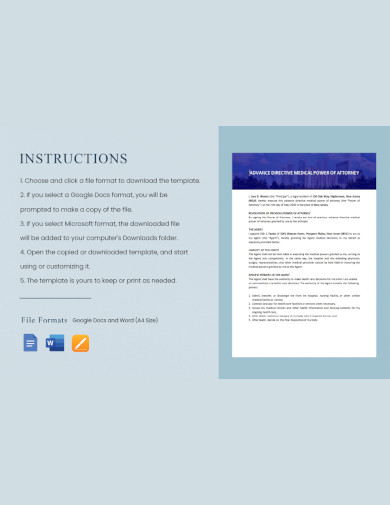
2. Advance Directive Power of Attorney Form
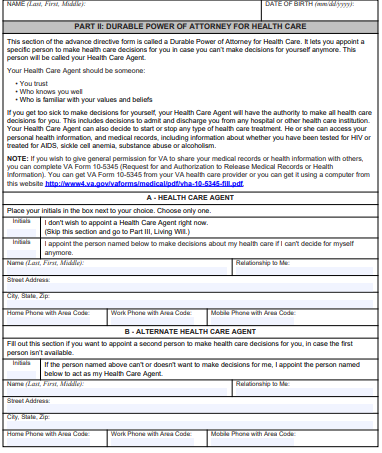
3. Advance Health Care Directive Power of Attorney Forms
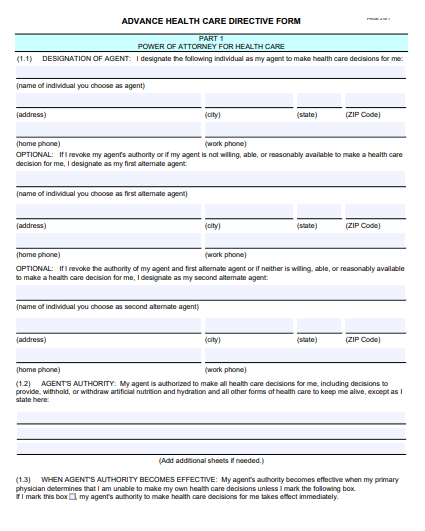
4. Durable Advance Directive Power of Attorney Forms
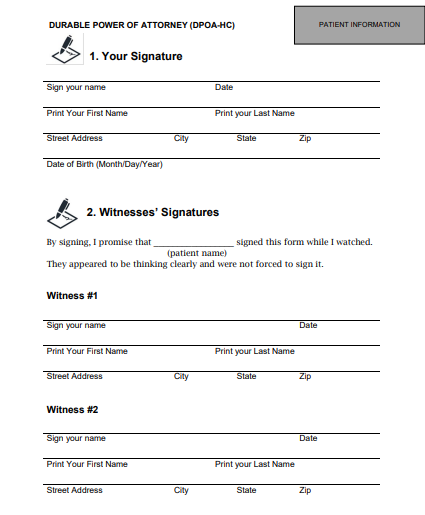
5. Simple Advance Directive Power of Attorney Forms

6. Arizona Advance Directive Power of Attorney Forms
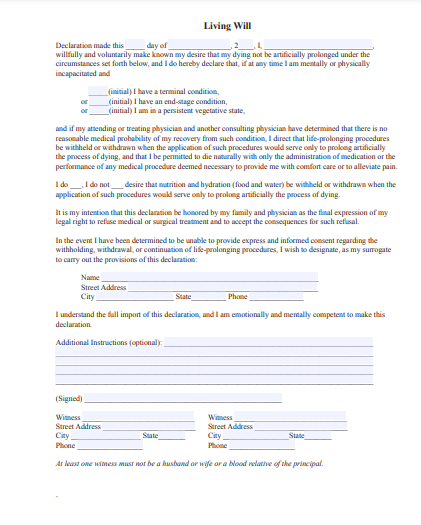
7. Special Advance Directive Power of Attorney Forms
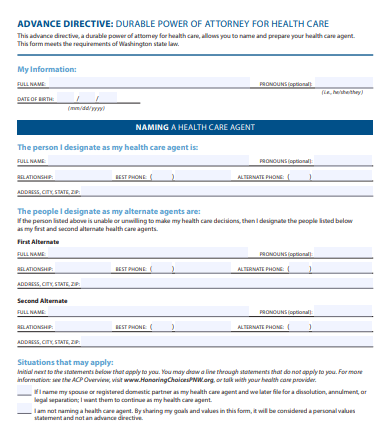
8. Georgia Advance Directive Power of Attorney Forms
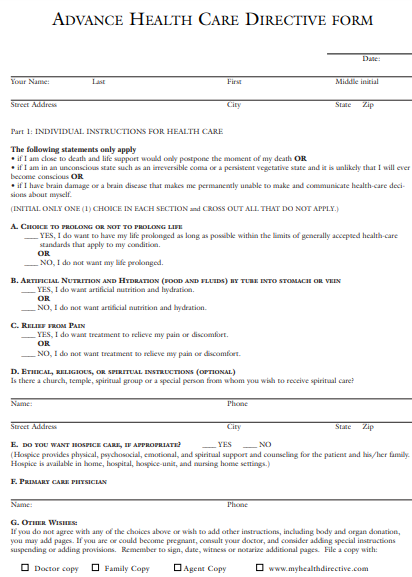
9. California Advance Directive Power of Attorney Forms
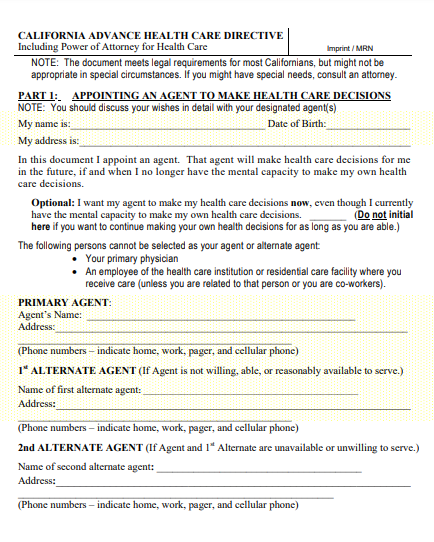
10. Standard Advance Directive Power of Attorney Forms
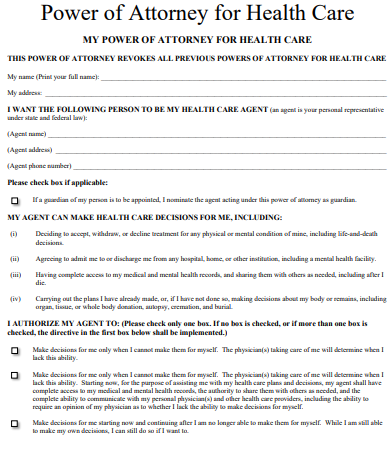
11. Pennsylvania Advance Directive Power of Attorney Forms

What are the most common 3 types of advance directives?
How is advanced directive used?
An advanced directive is used to communicate an individual’s healthcare preferences for situations where they might be unable to make decisions themselves due to illness or incapacity. It typically includes instructions on the types of medical treatment they wish to receive or avoid, such as life-sustaining measures. When medical decisions need to be made, healthcare providers refer to the advanced directive to guide their actions in accordance with the patient’s stated wishes. Additionally, if a healthcare proxy or agent is appointed in the directive, this person is authorized to make medical decisions on behalf of the individual, ensuring that their healthcare choices are respected and followed.
Can I change my Advance Directive Power of Attorney?
Yes, you can change your Advance Directive Power of Attorney. As long as you are mentally competent, you have the right to revise or revoke your Advance Directive at any time. To make changes, you should create a new document reflecting your updated wishes and ensure it’s properly executed according to your state’s laws. It’s also important to inform your healthcare agent, family, and healthcare providers about the changes and replace any old copies with the new version to avoid confusion.
How to revoke an Advance Directive Power of Attorney?
How detailed should healthcare wishes be in an Advance Directive Power of Attorney?
In an Advance Directive Power of Attorney, healthcare wishes should be as detailed as possible. This specificity helps ensure that your exact preferences regarding medical treatment and care are known and can be followed. Detailing your wishes about life-sustaining treatments, resuscitation, mechanical ventilation, and other specific medical interventions provides clear guidance to healthcare providers and your appointed agent. It’s also beneficial to include your values and general health care goals to guide decisions in scenarios that you may not have explicitly addressed. The more detailed your directive, the more likely it is that your healthcare preferences will be accurately honored.
How to Create the Auto Power of Attorney Form?
To create an Advance Directive Power of Attorney, follow these steps:
- Understand Your Preferences: Reflect on your healthcare values and treatment preferences.
- Choose a Healthcare Agent: Select a trusted individual who understands your wishes and is willing to make healthcare decisions on your behalf.
- Obtain a Form: Get an Advance Directive form, either from a healthcare provider, legal professional, or a reliable online source.
- Fill Out the Form: Clearly state your healthcare preferences and provide the necessary details about your chosen agent.
- Review Legal Requirements: Ensure your form meets state-specific legal criteria, including witnessing or notarization if required.
- Sign and Date the Form: Complete the form by signing and dating it in accordance with legal requirements.
- Distribute Copies: Provide copies to your healthcare agent, family members, and healthcare providers.
- Review Periodically: Regularly review and update your Advance Directive as your preferences or circumstances change.
Remember, consulting with a healthcare provider or legal professional can provide valuable guidance in this process.
Tips for creating an Effective Advance Directive Power of Attorney
- Reflect on Your Values: Consider your beliefs and preferences regarding healthcare and end-of-life care.
- Be Specific: Clearly articulate your wishes for medical treatments, life support, and resuscitation.
- Choose the Right Agent: Select someone who understands your values and is willing to advocate for your healthcare choices.
- Consult Healthcare Professionals: Seek advice from healthcare providers to understand medical options and implications.
- Understand Legal Requirements: Ensure your directive complies with state laws, which may include witnessing or notarization.
- Regularly Review and Update: As your situation or preferences change, revise your directive to keep it current.
- Communicate with Family: Discuss your decisions with family members to reduce potential conflicts or confusion later on.
An effective Advance Directive Power of Attorney provides clear guidance for your healthcare, aligning with your values and legal requirements.
Do Directives Need to Be Signed?
Yes, advance directives need to be signed by the individual creating them to be legally valid.
When Should I Make an Advance Directive?
It’s advisable to create an advance directive while you are healthy and able to make informed decisions about your healthcare preferences.
Difference Between a Living Will and Durable Power of Attorney for Health Care
A Living Will specifies medical wishes, whereas a Durable Power of Attorney for Health Care appoints someone to make decisions on your behalf.
Are Advance Directives Legally Binding?
Yes, advance directives are legally binding once properly completed and executed according to state laws.
What is a Medical Power of Attorney?
A Medical Power of Attorney is a legal document appointing someone to make healthcare decisions for you if you’re unable to do so.
Advance Directive Power of Attorney documents are crucial for ensuring your healthcare wishes are respected. Our guide and examples provide a comprehensive roadmap for writing these directives effectively. With practical tips on clarity, legal compliance, and choosing the right healthcare agent, you can create a document that accurately reflects your medical preferences. Remember, a well-prepared Advance Directive brings peace of mind and clarity to both you and your loved ones.
Related Posts
-
10+ Free New Hampshire (NH) Power of Attorney Form Download – How to Create Guide, Tips
-
10+ Free Nevada (NV) Power of Attorney Form Download – How to Create Guide, Tips
-
10+ Free Nebraska (NE) Power of Attorney Form Download – How to Create Guide, Tips
-
10+ Free Montana (MT) Power of Attorney Form Download – How to Create Guide, Tips
-
10+ Free Missouri (MO) Power of Attorney Form Download – How to Create Guide, Tips
-
10+ Free Minnesota (MN) Power of Attorney Form Download – How to Create Guide, Tips
-
10+ Free Mississippi (MS) Power of Attorney Form Download – How to Create Guide, Tips
-
10+ Free Massachusetts (MA) Power of Attorney Form Download – How to Create Guide, Tips
-
10+ Free Maryland (MD) Power of Attorney Form Download – How to Create Guide, Tips
-
10+ Free Maine (ME) Power of Attorney Form Download – How to Create Guide, Tips
-
10+ Free Louisiana (LA) Power of Attorney Form Download – How to Create Guide, Tips
-
10+ Free Kentucky (KY) Power of Attorney Form Download – How to Create Guide, Tips
-
10+ Free Kansas (KS) Power of Attorney Form Download – How to Create Guide, Tips
-
10+ Free Iowa (IA) Power of Attorney Form Download – How to Create Guide, Tips
-
10+ Free Indiana (IN) Power of Attorney Form Download – How to Create Guide, Tips
